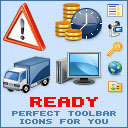


|
| ||||||||
|
|
Gift Icon |
|
Image sizes: 256x256, 128x128, 64x64, 48x48, 32x32, 24x24, 20x20, 16x16, 512x512
File formats: BMP, GIF, PNG, ICO
Get Your Graphics in Order
Whether you are using jpgs, pngs or eps files, you would like to make the files that you upload to your internet site as tiny as practical.When it comes to graphics and site design, you are going to need to think small. Most good images should be around 10-12KB per image. Whether or not you are using jpgs, pngs or eps files, you need to make the files that you upload to your internet site as small as practicable. Giant images are the reason that pages load slowly.
Use the kinds of graphics that fit the content. For example, if you're putting up a domain that's all about ferrets, you don't want to put an image of a dog on your internet site. The picture might be awfully cute, and you can like it a lot, but mull it over from the reader's standpoint. They're visiting your internet site because they want to learn about ferrets.
When using photos, try and use compressed files : quarrels and JPGs are best. Avoid using photographs that move, blink, flash or revolve. Studies have shown that these sorts of photographs only irritate and distract surfers which is not what it is all about. What they will wind up doing is cover up the flashing, blinking irritation to read the copy, or worst still, they'll just leave.
Use vector graphics instead of raster graphics. Vector images are defined by mathematics, not pixels. They can be scaled up or down without any loss of quality. Programs like Illustrator make vector pictures, and Photoshop makes raster pictures. There are two reasons why you would like to use vector graphics - they are much smaller than their raster opposite number, and if you blow it up, it won't pixelate. This is good for Web 2.0 graphics and things like buttons or navigation aids on your website.
Vector formats include EPS ( encapsulated sequel ), AI ( Adobe Illustrator ), WMF ( Windows Metafile ), DXF ( AutoCAD ), CDR ( CorelDraw ), PLT ( Hewlett Packard Graphics Language Plot File ) and SVG ( Scalable Vector Graphics ). Sizing down or up in Adobe Illustrator then saving the file as a JPEG makes for a very small graphic file.
Photos are generally raster images, so you want to make them as little as practical. The common raster image formats include BMP ( Windows Bitmap ), PCX ( Paintbrush ), JPEG ( Joint Photographics Expert Group ), row ( Tag Interleave Format ), PNG ( conveyable Network Graphic ), GIF ( Graphics Interchange Format ), CPT ( Corel PhotoPAINT ) and PSD ( Adobe PhotoShop ).
When it comes to the use of pictures on your page, you will want to wrap text around it. Sometimes stills and graphics should add to the layout and not take it over or overwhelm the look and feel of what is presented to the reader. The content is of primary seriousness with the graphics adding to the readability and experience of what is being presented.
Copyright © 2006-2022 Aha-Soft. All rights reserved.
|

